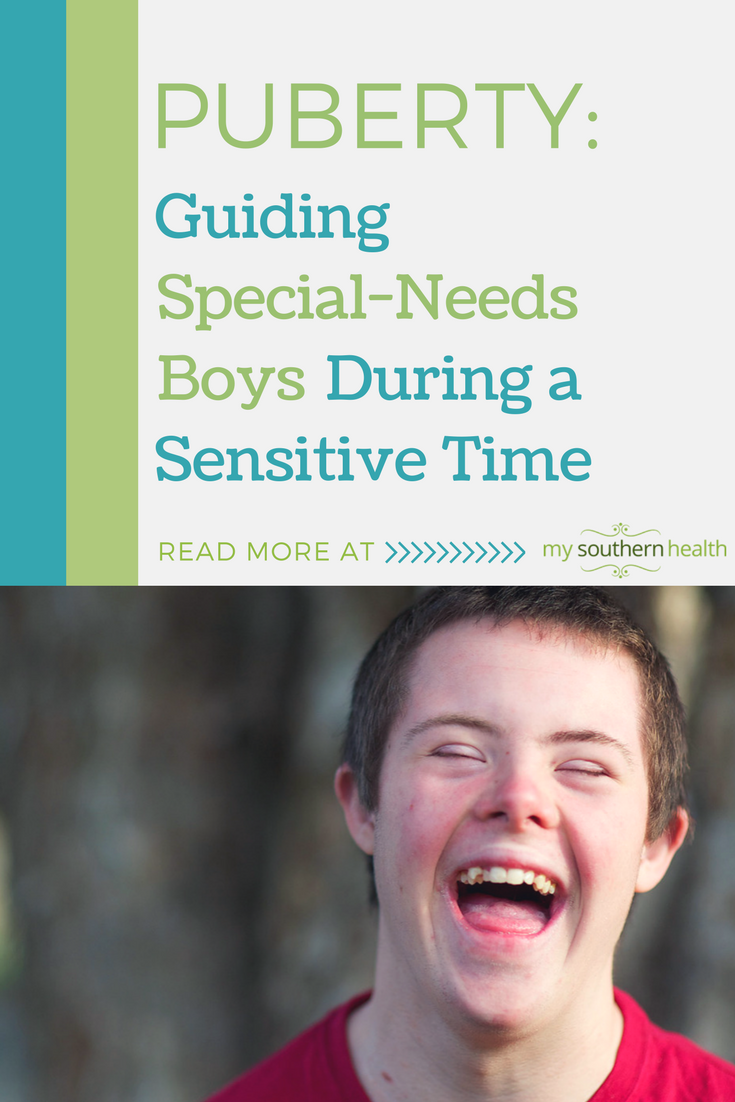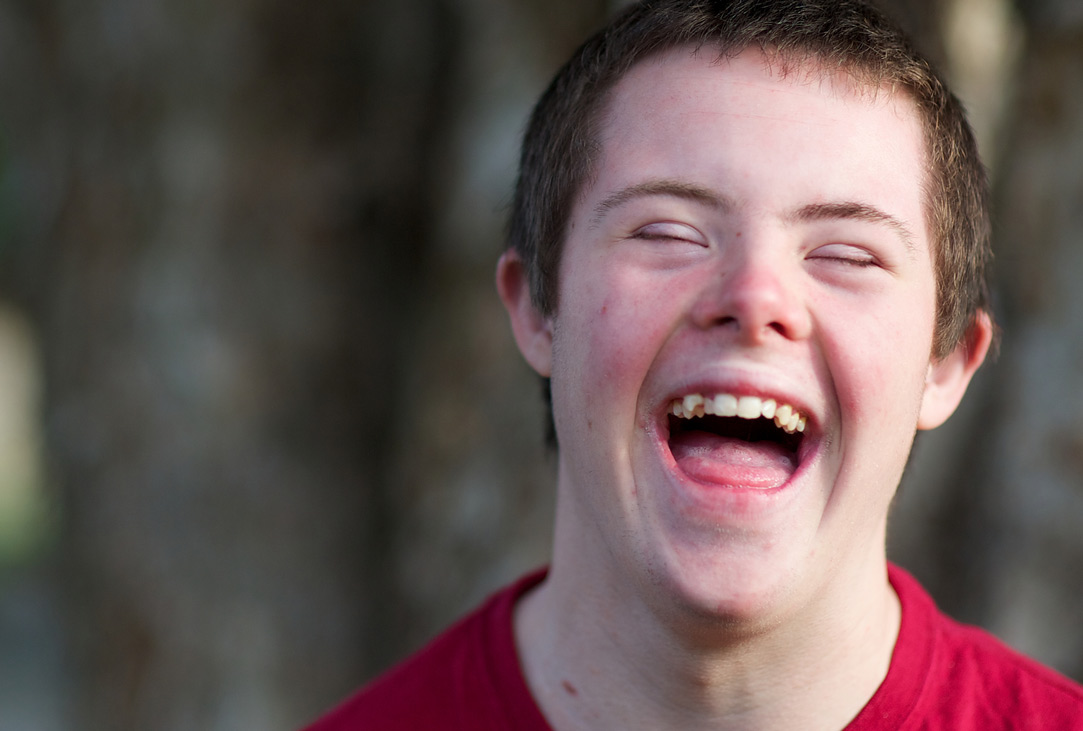Our tips for how to handle puberty with a special needs child.
Though special-needs children have developmental disabilities in some areas, they generally hit puberty at the same age as their peers – anywhere from age 9 (or possibly earlier) to 15.
Helping boys navigate puberty can be awkward regardless of the circumstances, but families raising special-needs kids have additional challenges. The Vanderbilt Kennedy Center, which supports people with disabilities and their families, publishes a guide, “Healthy Bodies for Boys,” with these tips for teaching your son (and you!) to handle puberty as gracefully as possible.
Don’t wait until your son hits puberty to talk to him about it. Start before the obvious signs are there. Changes in his body and the ways it functions can be scary if he doesn’t understand what’s happening.
Choosing words
Make sure to use the correct words for body parts — for example, penis — and bodily functions, such as erection, urination and ejaculation. This makes it easier to talk about everything from hygiene to reproduction.
Physical activity
Make physical activity a priority. Schedule some time every day for your son to get some exercise. Join in to encourage him.
If your son has motor impairments, ask his doctor or therapist for safe exercises he can do. There may be adapted activities in your area designed for teens with special needs.
Reward him for physical activity, but do not use food to encourage exercise.
Nocturnal emissions
Boys entering puberty ejaculate in their sleep. This is a nocturnal emission, or a “wet dream.” These usually start between ages 13 and 17, with an average age of 14. Explain to your son that his penis will release semen, and that he might wake up with a wet spot in his underwear or on his sheets, so he doesn’t think he wet the bed. This is normal, and not something he can control. Use social stories and visuals to help explain and normalize this process.
Teach your son what to do after they happen. Depending on his abilities, this may include changing the sheets, putting dirty laundry in a hamper and washing his private parts with a wipe or wet cloth. If your son can’t clean up on his own, find a way for him to let you know that he needs help – for example, hanging a “sheets are dirty” sign on his door, like hotels use “do not disturb” signs.
Erections
During puberty, teenage boys have several erections every day. It’s normal and not something they can control. Use social stories and visuals to prepare your son and give him some ideas about what to do if it happens in public: Stay seated until his erection goes away; carry his books low to block his private area; or tie a jacket around his waist. Consider helping him choose clothes and underclothes that may make erections less noticeable.
Teaching hygiene
Good hygiene habits make your son more independent and confident. Let him help create hygiene “kits.” These can be made baskets, shoe boxes, plastic containers – whatever he likes. Stock each kit with everything needed for a certain task and label the kit for that task. For example, a shower kit might contain body wash or soap, shampoo and conditioner and a razor.
Ramp up hair care. Teens need to wash their hair more frequently than younger children. The motor demands of this task might make shampooing challenging for your son, or he may not grasp that at this age, classmates pay close attention to cleanliness. Create a schedule for how often he should wash his hair. If the sensory aspects of washing his hair are a problem, try using a sponge, a shampoo soap bar, gloves or a plastic visor to keep water from his eyes.
Prevent body odor. Sweat glands become more active during puberty, so young teens need to learn to use deodorant, wear clean clothes and keep their bodies clean. Again, visual checklists can help your son take charge of these tasks. If applying deodorant is physically difficult for him, try different types, such a roll-ons or sprays. If he cannot bathe independently, try using bath seats, a removable showerhead, extended scrubbing handles or scrubbing gloves to make the task easier for him.
Keep clean teeth, clean breath. Create a visual schedule for when he should brush and floss his teeth. An electric toothbrush might be easier for him to manage than a plain manual one. Timers or songs can help him know how long to brush. (Dentists recommend two minutes.)
Ease him into shaving. Use a drawing of the male body to teach your son where hair grows.
Let your son watch you or an older sibling shave. Make a list of the steps. Have him practice each step with you. If he can shave on his own, use a calendar with pictures or marks to remind him when to shave and when to change his razor. If your son has trouble with fine motor control, try an electric razor. But if he prefers a traditional razor with a blade, ask his occupational therapist about weighted razors or a razor universal cuff to help him with his grip.
Public vs. private
Explain to your son what parts of his body are “private parts” – a simple way to convey this is to describe or illustrate them as parts that are covered by underwear or a swimsuit.
Kids with developmental delays may need help learning what behavior is acceptable in public and what should remain private. Teach your son about things that should only be done in private, such as going to the bathroom, changing clothes, touching private parts, passing gas and more. When he does things such as adjusting his underwear or touching his private parts, redirect him to an appropriate place by telling him, “you can do that in your bedroom/bathroom” or by showing him a visual of a “private place” or alternate behavior.
If your son needs help with private tasks, such as getting dressed or using the toilet, teach him how and who to ask for help when he is out in public, such as at a restaurant or at school. With him, think through how to plan ahead, ask discreetly for help, or make visual cards he can use to request help.
All kids touch their private parts sometimes. Shaming or punishing your son for doing it is likely to confuse him and make him less likely to ask you questions, and the attention might make him more likely to do it rather than less. Better to teach him to keep this behavior private. Use a visual signal to remind him of the rule (“no hands in pants”), to shift him to some other action he can’t do at the same time, such as “hands on the table” or to remind him to go to a private place, such as his bedroom. Be aware that kids may touch their private parts if they hurt or itch. If your son seems to be touching his private parts frequently, he could have an infection, irritated skin or some other problem that needs a doctor’s attention.
Teach your son what’s appropriate to talk about in public and what’s not. For example, nocturnal emissions, erections and masturbation are private, something that’s OK to talk about only with parents, doctors or the school nurse – not with friends, teachers or strangers.
Puberty and moodiness
Puberty can create a lot of emotional ups and downs. Teach your son to express feelings. If he is verbal, help him name his emotions (“It sounds like you’re angry”). If he is not verbal, use pictures of facial expressions he can show you to express his feelings.
Kids with disabilities are at higher risk than their peers for mental health problems that require counseling. Signs that your son is experiencing anxiety, depression or other medical conditions that mimic depression include crying, shouting or laughing for no reason; compulsive behavior; aggression; troubled sleep; confusion; withdrawing from things he used to enjoy; and more. If you note drastic changes in his behavior and mood, talk with your pediatrician about a medical work-up and referral to a mental health professional.
Teaching strategies
Many kids will need more than just an explanatory chat to learn these skills and rules. Take your son’s learning style into account. Start early, and keep practicing skills after the first lesson.
- Use images when talking about bodies and puberty. If repetition helps, break information into small, simple facts and go over them frequently.
- Making a picture book might help when you’re teaching him how to take care of himself. Let him help create it. How many images you include and how simple or detailed you make it should vary according to his cognitive level and memory. Include pictures of supplies he needs – for example, soap, shampoo, deodorant, a razor, etc. Create pictures that explain when he needs to perform certain hygiene tasks and what supplies he needs for each step.
- Laminate an image of a boy’s body to serve as a checklist for hygiene tasks. For example, a shower checklist can be in the form of a picture of a male body. Attach it to the shower with Velcro. List the steps for each shower (wash hair, scrub under arms, etc.), with the steps marked on the right body part on the laminated image.
- If your son needs help understanding the difference between public and private places, make a list of public places versus private ones, and what behaviors are appropriate where. With your son, think of examples of behaviors that are appropriate for each setting. Make lists using text or pictures.
- Create a schedule for how often he needs to do each task – for example, taking a bath or shower daily, or combing his hair before leaving the house.
- To help him learn how long to stay in the shower or bath, a music playlist of songs that runs for the right amount of time can be a helpful cue. Each new song can signal when to move to the next step on the list.
- Use social stories. Think about situations and behaviors that are difficult for your son, and create a first-person story that explains the social rules for that situation and what other people may be thinking or feeling in that circumstance.

This article is based on a guide, “Healthy Bodies for Boys,” which the Vanderbilt Kennedy Center has available as a free download. The Kennedy Center also publishes a similar guide for girls. The guides contains all of these tips, many more, and a list of resources for families of children with disabilities.

